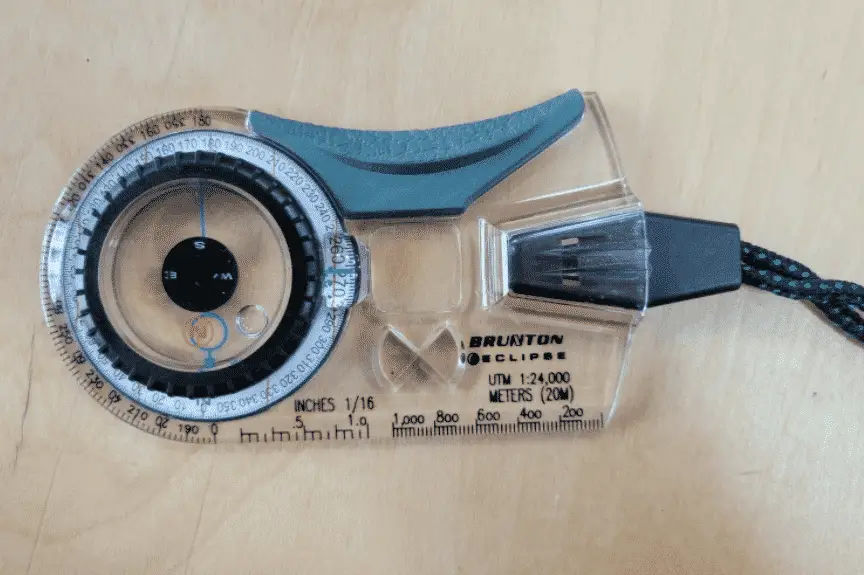Bubbles in your compass can really drive you crazy. It seems like a bubble has formed in every compass I’ve ever purchased. Why does it seem like every compass has an air bubble and does the bubble serve an actual purpose?
Should a Compass Have an Air Bubble? A compass should not have an air bubble under normal operating conditions. Bubbles form when the compass is exposed to high altitude and cold weather conditions. Small bubbles shouldn’t affect the compass performance, but there are ways to remove air bubbles.
Don’t be tempted to smash your compass and throw it in the trash just because it has a few bubbles. Continue reading to find out how to remove air bubbles from your compass.
Table Of Contents
Why Is There an Air Bubble In My Compass?

Most modern orienteering compasses use some form of liquid to reduce needle oscillations. It really helps to increase accuracy, but small air bubbles will eventually form.
Even the best compasses on the market from companies like Brunton, SUUNTO, and Silva, will eventually develop bubbles. The Brunton compass in the picture above was about $75 and I’ve been dealing with bubble issues forever. They will go away, but they always come back.
So, why is there a bubble in my compass? With any liquid you will eventually have to deal with bubbles. They form at elevation and when the ambient temperature significantly decreases. In both instances the volume of liquid reduces faster than the plastic/glass compass capsule can contract so a small bubble forms to fill in the gap.
Do All Compasses Develop Air Bubbles?
Most liquid filled compasses develop air bubbles, but some will be better than others. Cheap compasses may even develop bubbles at normal temperatures. Whether or not the bubble goes away will depend on the liquid that’s inside the compass.
Cheap compasses are usually filled with water which will freeze contract/expand and damage the casing. More expensive compasses are usually filled with some kind of light oil like kerosene, ethyl alcohol, white spirits, mineral oil or lamp oil.
Bubbles Can Be a Good Thing
Bubbles might look annoying, but they can actually be a good thing. Compasses are designed so that bubbles will form in extreme weather conditions. They act as an air cushion, giving the glass capsule a buffer when the oil expands at higher temperatures. You don’t want the case to break when the weather gets hot and the oil expands.
Once A Bubble Starts It Will Only Get Bigger
A small air bubble won’t cause accuracy issues in your compass, but a small bubble will eventually get bigger. Try not to ignore small air bubbles for long. Most bubbles should go away at normal summer temperatures. I’ll explain how to get rid of air bubbles at the end of this article.
Larger Bubbles May Be A Leak

You probably have a leaking capsule if a bubble is larger than 1/4 inch in diameter. This is usually the result of some type of shock damage cracking the capsule. Cheap compasses will usually have to be replaced, but pricier models can sometimes be repaired. Check the warranty on your compass to see if they offer free repairs.
There’s usually an issue with the compass’s base or housing that’s allowing oil to leak out. The accuracy of your compass will be affected so try to get it repaired or buy a new compass. If you’re unsure if the compass is leaking, place it on a paper towel to see if any liquid leaks out.
Does a Bubble Affect Compass Accuracy?
Don’t Worry! A small bubble in your compass shouldn’t affect its accuracy. Almost every compass will eventually develop a small bubble, but they rarely cause any problems with compass accuracy. Only very expensive compasses can withstand high altitude and cold weather conditions.
You only run into problems when multiple bubbles form or the bubble gets too big. Larger bubbles can affect the needle movement in those instances. Once the bubble gets too big you’ll have to try and get it out or pick up a new compass.
Compasses Rarely Work In Very Cold Weather
Most liquid orienteering compasses are designed to work at temperatures above 0 Degrees Celsius (32 Degrees Fahrenheit). You need a compass that doesn’t have liquid in cold weather conditions. They tend to be very expensive so you need to be serious.
How to Get Air Bubbles Out of a Compass
A small air bubble shouldn’t be much of an issue, but you should still try to get rid of them. It can be hard to get rid of large bubbles once they form. Usually bubbles will disappear when the compass is returned to sea level or room temperature. You need additional heat if that doesn’t work.
Try placing your compass in a warm sunny spot like on your windowsill or front porch. You want the liquid to heat up, expand and return to its normal volume. On the trail, place the compass in your jacket/pant pocket and allow your body heat to warm it up.
If you can’t get rid of the bubble under normal working conditions most manufacturers will replace it with no questions asked under the warranty period.



